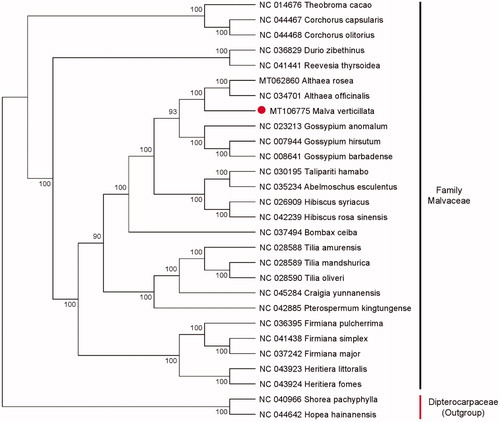Abstract
Malva verticillata L. is an important perennial herb with significant medicinal value. The complete chloroplast (cp) genome of M. verticillata was 158,408 bp in length, which contained a large single-copy (LSC) region of 87,085 bp, a small single-copy (SSC) region of 21,109 bp, and a pair of inverted repeats (IRs) region of 25,107 bp. The overall GC content was 37.12%. The genome harbored 129 genes, including 84 protein-coding genes, 37 tRNA genes, and 8 ribosomal RNA genes. Phylogenetic analysis indicated that M. verticillata is closely related to Althaea officinalis.
Malva verticillata L. is a perennial species of the family Malvaceae, which is widely distributed in China, India, Sikkim, Myanmar, North Korea, Ethiopia, Egypt, and Europe (Ya et al. Citation2007). This plant is used as a popular leafy vegetable (Ya et al. Citation2007) in East Asia, Korea, and China for a long time (Odontuya Citation2012). Furthermore, its seed, commonly known as Dong-Kui-Zi, has long been used as traditional Chinese medicines for the treatment of diuretic, laxative, and galactopoietic (Shim et al. Citation2016). So far, most of the studies on genus Malva were focused on chemical composition, biological activity, morphological taxonomy, and molecular phylogeny (Shim et al. Citation2016). However, there is no cp genomic report on Malva to date. Herein, we assembled and characterized the cp genome of M. verticillata for the first time, which will provide useful information for further study of the genus.
Fresh leaves of M. verticillata were collected from the Cangshan mountain (25°41′4″N, 100°08′31″E) of Dali counties, Yunnan province, China. The voucher specimen was deposited in the herbarium of Dali University (LJ2020010510). Total DNA was extracted using the DNeasy plant mini kit (QIAGEN), and sequenced by Illumina NovaSeq system (San Diego, CA). Approximately 6.63 Gb of raw data (44,238,066 reads) were assembled by NOVOPlasty (Dierckxsens et al. Citation2017; Park et al. Citation2019), and the assembled cp genome was annotated by GeSeq with default sets (Michael et al. Citation2017). The annotated cp genome was submitted to the GenBank with the accession number MT106775.
The cp genome of M. verticillata was 158,408 bp in length with a typical quadripartite structure of angiosperms, which contained a large single-copy (LSC) region of 87,085 bp, a small single-copy (SSC) region of 21,109 bp, and a pair of inverted repeats (IRs) region of 25,107 bp. It harbored 129 genes, including 84 protein-coding genes, 37 tRNA genes, and 8 ribosomal RNA genes. The overall GC content was 37.12%. To investigate the phylogenetic relationship of M. verticillata, other cp genome of 25 species of Malvaceae from NCBI were aligned using MAFFT v7.307 (Katoh and Standley Citation2013). A maximum-likelihood (ML) tree was constructed using RAxML v8.2.12 (Stamatakis Citation2014), with Hopea hainanensis (NC_044642) and Shorea pachyphylla (NC_040966) as outgroup. The phylogenetic analysis showed that M. verticillata was closely related to Althaea officinalis (). The cp genome of M. verticillata will provide a valuable resource for the conservation genetics of this species as well as for the phylogenetic studies of Malvaceae.
Disclosure statement
The authors are grateful to the published genome data in the public database. No potential conflict of interest was reported by the author(s).
Additional information
Funding
References
- Dierckxsens N, Mardulyn P, Smits G. 2017. NOVOPlasty: de novo assembly of organelle genomes from whole genome data. Nucleic Acids Res. 45(4):e18.
- Katoh K, Standley D. 2013. MAFFT multiple sequence alignment software version 7 improvements in performance and usability. Mol Biol E. 4(30):772–780.
- Michael T, Pascal L, Tommaso P, Ue S, Axel F, Ralph B, Stephan G. 2017. GeSeq – versatile and accurate annotation of organelle genomes. Nucleic Acids Res. 45(W1):W6–W11.
- Odontuya G. 2012. Pharmacological activities of a mongolian medicinal plant, Malva mohileviensis Down. Eur J Med Plants. 3(2):230–241.
- Park J, Choi YG, Yun N, Xi H, Min J, Kim Y, Oh S. 2019. The complete chloroplast genome sequence of Viburnum erosum (Adoxaceae). Mitochondrial DNA B. 2(4):3278–3279.
- Shim KS, Lee CJ, Yim NH, Ha H, Ma JY. 2016. A water extract of Malva verticillata seeds suppresses osteoclastogenesis and bone resorption stimulated by RANK ligand. BMC Complem Altern Med. 1(16):332.
- Stamatakis A. 2014. RAxML version 8: a tool for phylogenetic analysis and post-analysis of large phylogenies. Bioinformatics. 9(30):1312–1313.
- Ya T, Gilbert MG, Dorr LJ. 2007. Flora of China. Vol. 12. Beijing: Science Press; Louis (MI): Missouri Botanical Garden Press.

